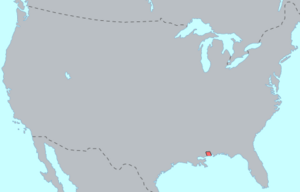Biloxi language facts for kids
Quick facts for kids Biloxi |
||||
|---|---|---|---|---|
| Tanêksąyaa ade | ||||
| Native to | United States | |||
| Region | Mississippi, Louisiana | |||
| Extinct | 1930s, with the death of Emma Jackson | |||
| Language family |
Siouan
|
|||

Pre-contact distribution of the Biloxi language.
|
||||
|
||||
The Biloxi language was a special language spoken by the Biloxi tribe. They lived in what is now Mississippi, Louisiana, and southeastern Texas in the United States. Sadly, this language is no longer spoken today.
Contents
History of the Biloxi Language
The Biloxi tribe first met Europeans in 1699, near the Pascagoula River. By the mid-1700s, they had moved and settled in central Louisiana. Some Biloxi people were also seen in Texas in the early 1800s.
Over time, the number of Biloxi speakers became very small. By 1934, the last person who spoke Biloxi as their first language was Emma Jackson. She was in her eighties. Two language experts, Morris Swadesh and Mary Haas, spoke with her in 1934. They confirmed that she was indeed a native speaker of the Biloxi language. After her death, the language became extinct.
Language Family
Biloxi is part of the Siouan language family. This family includes many languages spoken by Native American tribes. Biloxi is specifically an Ohio Valley or Southeastern Siouan language. It is closely related to the Ofo and Tutelo languages.
Sounds of Biloxi
The Biloxi language had its own unique set of sounds, just like English has its own sounds.
Vowels
Biloxi had several vowel sounds. Some of these vowels could also be nasalized, meaning air came out of the nose when saying them, similar to the "on" sound in French words like "bon." Vowels could also be long or short, which changed the meaning of words.
For example:
- ide meant 'it falls'
- įde (with a nasalized 'i') meant 'dung, manure'
Consonants
Biloxi also had a range of consonant sounds. Some of these sounds were similar to English, while others were different.
For example:
- pa meant 'head'
- ma meant 'ground'
- ti meant 'house'
How Biloxi Words Work
In Biloxi, words were built using different parts. These parts could be verbs (action words), nouns (names of things or people), or particles (small words that add meaning).
Building Nouns
Some nouns in Biloxi could change their form depending on who owned them or how many there were. For example, words for body parts or family members would change.
- dodi meant 'throat'
- ndodi meant 'my throat'
- idodi meant 'your throat'
- doxtu meant 'their throats'
The Biloxi language also had pronouns, like "I," "you," "he," "she," "it," and "they." These were formed from a root word indi.
- nkindi meant 'I'
- ayindi meant 'you'
- indi meant 'he, she, it'
Building Verbs
Verbs in Biloxi were very important. They changed to show who was doing the action (first person, second person, third person) and how many people were doing it (singular or plural). They also changed to show the "mood" of the action, like if it was a statement, a question, or a command.
Here are some ways verbs changed:
- Declarative Mode: This was used for making statements. Male speakers used na at the end of a sentence, while female speakers used ni.
* nkadutedą ni meant 'I have finished eating' (female speaker).
- Interrogative Mode: This was for asking questions. Male speakers used wo, and female speakers often didn't add a special marker, relying on tone.
* iyixǫ wo meant 'have you had enough?' (male speaker).
- Imperative Mode: This was for giving commands. Different endings were used depending on who was speaking and who they were speaking to.
* eyąhį ta meant 'come!' (male speaker to male). * dǫ te meant 'look at him!' (female speaker to male).
- Negative Mode: To say something was not happening, Biloxi often used (ku)...ni.
* kudǫxtu ni xti meant 'they could not see them at all'.
Making New Words
Biloxi could create new words by combining existing ones or by adding small parts to words.
- Combining Words:
* peti (fire) + ti (house) became petiti meaning 'fireplace'. * ąyadi (people) + ade (talk) became ąyadiade meaning 'language'.
- Reduplication: Sometimes, part of a word was repeated to make the meaning stronger or to show something was happening many times or in many places.
* cake meant 'hang up on a nail'. * cakcake meant 'he hung up a lot'.
Numbers in Biloxi
Biloxi had its own way of counting.
- sǫsa meant 'one'
- nǫpa meant 'two'
- ohi meant 'ten'
Numbers from 11 to 19 were formed by saying "ten" and then "X sitting on Y."
- ohi sǫsaxehe meant 'eleven' (literally 'one sitting on ten').
Numbers like 20, 30, and so on were formed by saying "X tens."
- ohi nǫpa meant 'twenty' (literally 'two tens').
Larger numbers included:
- tsipa meant '100'
- tsipįciyą meant '1000' (literally 'old man hundred').
To say "once," "twice," etc., they used the verb de ('to go') before the number.
- de sǫsa meant 'once'
- de nǫpa meant 'twice'
How Sentences Were Built
Biloxi sentences usually followed a Subject-Object-Verb (SOV) order. This means the person or thing doing the action came first, then the thing being acted upon, and finally the action itself. For example, in English we say "I eat apples," but in Biloxi, it would be more like "I apples eat."
- (Connective) (Subject) (Object) (Adverb) Verb (Connective)
This structure is different from English, where we usually say Subject-Verb-Object (SVO).
See also

